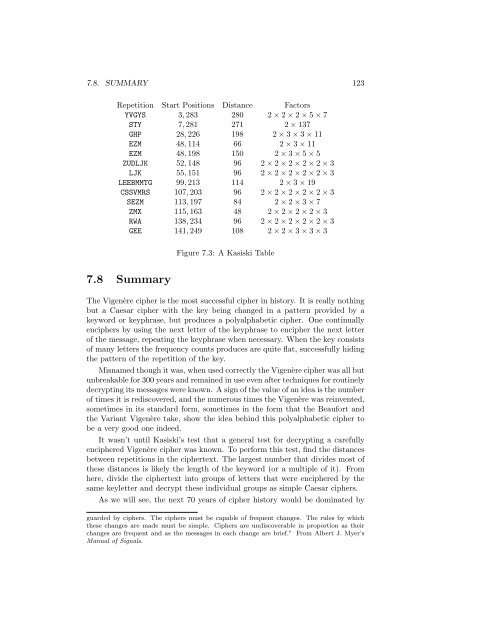Cryptology - Unofficial St. Mary's College of California Web Site
Cryptology - Unofficial St. Mary's College of California Web Site
Cryptology - Unofficial St. Mary's College of California Web Site
You also want an ePaper? Increase the reach of your titles
YUMPU automatically turns print PDFs into web optimized ePapers that Google loves.
7.8. SUMMARY 123<br />
Repetition <strong>St</strong>art Positions Distance Factors<br />
YVGYS 3, 283 280 2 × 2 × 2 × 5 × 7<br />
STY 7, 281 271 2 × 137<br />
GHP 28, 226 198 2 × 3 × 3 × 11<br />
EZM 48, 114 66 2 × 3 × 11<br />
EZM 48, 198 150 2 × 3 × 5 × 5<br />
ZUDLJK 52, 148 96 2 × 2 × 2 × 2 × 2 × 3<br />
LJK 55, 151 96 2 × 2 × 2 × 2 × 2 × 3<br />
LEEBMMTG 99, 213 114 2 × 3 × 19<br />
CSSVMRS 107, 203 96 2 × 2 × 2 × 2 × 2 × 3<br />
SEZM 113, 197 84 2 × 2 × 3 × 7<br />
ZMX 115, 163 48 2 × 2 × 2 × 2 × 3<br />
RWA 138, 234 96 2 × 2 × 2 × 2 × 2 × 3<br />
GEE 141, 249 108 2 × 2 × 3 × 3 × 3<br />
Figure 7.3: A Kasiski Table<br />
7.8 Summary<br />
The Vigenère cipher is the most successful cipher in history. It is really nothing<br />
but a Caesar cipher with the key being changed in a pattern provided by a<br />
keyword or keyphrase, but produces a polyalphabetic cipher. One continually<br />
enciphers by using the next letter <strong>of</strong> the keyphrase to encipher the next letter<br />
<strong>of</strong> the message, repeating the keyphrase when necessary. When the key consists<br />
<strong>of</strong> many letters the frequency counts produces are quite flat, successfully hiding<br />
the pattern <strong>of</strong> the repetition <strong>of</strong> the key.<br />
Misnamed though it was, when used correctly the Vigenère cipher was all but<br />
unbreakable for 300 years and remained in use even after techniques for routinely<br />
decrypting its messages were known. A sign <strong>of</strong> the value <strong>of</strong> an idea is the number<br />
<strong>of</strong> times it is rediscovered, and the numerous times the Vigenère was reinvented,<br />
sometimes in its standard form, sometimes in the form that the Beaufort and<br />
the Variant Vigenère take, show the idea behind this polyalphabetic cipher to<br />
be a very good one indeed.<br />
It wasn’t until Kasiski’s test that a general test for decrypting a carefully<br />
enciphered Vigenère cipher was known. To perform this test, find the distances<br />
between repetitions in the ciphertext. The largest number that divides most <strong>of</strong><br />
these distances is likely the length <strong>of</strong> the keyword (or a multiple <strong>of</strong> it). From<br />
here, divide the ciphertext into groups <strong>of</strong> letters that were enciphered by the<br />
same keyletter and decrypt these individual groups as simple Caesar ciphers.<br />
As we will see, the next 70 years <strong>of</strong> cipher history would be dominated by<br />
guarded by ciphers. The ciphers must be capable <strong>of</strong> frequent changes. The rules by which<br />
these changes are made must be simple. Ciphers are undiscoverable in proportion as their<br />
changes are frequent and as the messages in each change are brief.” From Albert J. Myer’s<br />
Manual <strong>of</strong> Signals.

















